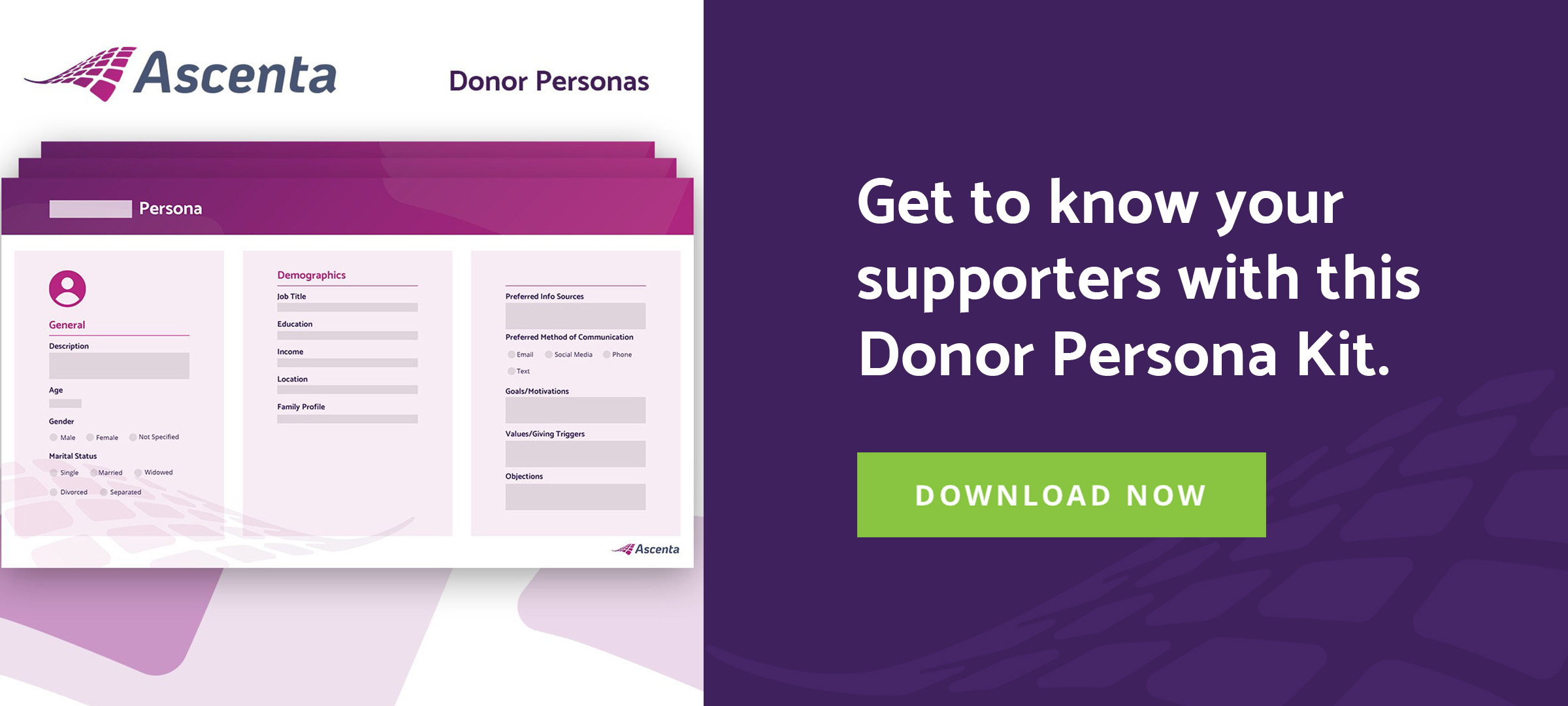Fundraising is essential for non-profit organizations (NPOs). A successful fundraising strategy will improve donor retention rates, increase donor lifetime value, and ultimately, achieve your goals. However, external factors like the stock market, real estate market, and even, the political climate can affect donor retention rates and make executing a successful fundraising strategy difficult to accomplish.
When creating your fundraising strategy, set a goal to improve donor retention rates and implement tactics that create long-lasting connections with partners and donors. Here are 11 steps you can follow to create a fundraising strategy that increases donor retention:
1.) Outline Your Charity’s Story & Cause
Your charity’s story is the basis of your NPO’s fundraising strategy. Simply put, the right story will connect people to your mission. All outreach tactics should exemplify your vision and values in a compelling way while supporting your NPO’s mission. Additionally, communication should be strategic, clear, and concise on every public platform:
- Website
- Marketing materials
- Social media
- Media and PR strategy
- Donor outreach materials
- Annual report
The key elements of your story should demonstrate:
- Why you do what you do
- How you’re doing it and how it’s different
- Who or what you help
- Evidence of your impact
- A call-to-action to get involved
Because your story is the guiding force of your organization, expect to go through several different drafts before settling on your final messaging. You’ll need to get buy-in from your executive leadership, board of directors, founders, and organizational leaders who head up your fundraising teams, donor relations and other functions.
2.) Identify Target Donor Audiences
Once your NPO’s story is written, adapt your messaging to speak directly to target donors. All communications should speak to people who will embrace your cause, believe in the impact you’re making, and support your charity on an ongoing basis. Generally speaking, target audiences can be defined by age, occupation, geographic region, and interest.
Why does establishing a target audience matter? Because varying audiences differ greatly in their approach to both giving and technology. For example, different age groups are motivated to donate for various reasons:
- Millennials: Are more active on their cell phones and social media than they are on email. They’re also likely to give nearly $500 annually.
- Gen X: Prefer text messages phone calls. They’re also motivated to be a part of the cause and are more likely to fundraise on behalf of your organization.
- Baby Boomers: These supporters are more likely to answer the phone. They may give online, but donations are usually prompted by a direct mail piece.
Once you identify your target audiences, diversify your campaign’s messaging to appeal to those audiences. Matching your messaging to your audience is essential to increasing donor retention, and correctly identifying target audiences is the first step.
3.) Analyze Previous Fundraising Efforts
If this isn’t your first attempt at fundraising, take some time to analyze your past campaigns. Look closely at all of the factors that went into each campaign including hours worked, funds raised, and total campaign impact. This will help give you a general baseline of what is possible for future campaigns, and also where to set strategic growth goals for greater impact.
You should also perform a SWOT analysis to assess past campaign’s strengths, weaknesses, opportunities, and threats. This exercise will enable you to review non-quantifiable factors that impact donor retention:
- Strengths: What worked well? What set this campaign apart?
- Weaknesses: What went wrong? What factors negatively impacted the success of this campaign?
- Opportunities: What can be done differently next time?
- Threats: What internal and external factors are impacting campaign performance?
4.) Review Your Organizational Goals
A fundraising strategy should simultaneously accelerate your campaign and organizational goals. Your organizational goals are typically measured by overall funds raised, total annual impact, and the percentage of one-time donors to recurring donors. They may also be non-quantifiable including creating better working relationships with community leaders, reaching more communities, or elevating your messaging to reach more people.
Many NPOs make the mistake of focusing just on their specific campaign fundraising goals. This type of narrow focus can lead to disjointed messaging and campaigns that confuse donors and decrease their overall connection to your cause.
5.) Set Specific Fundraising Goals
It’s important to set fundraising goals. The right goals will motivate your team, set clear expectations, and measure the success of your fundraising campaigns. Consider using the “SMART” approach to setting goals:
- Specific goals are sensible, simple, and significant.
- Measurable goals are meaningful and motivating.
- Attainable goals are achievable.
- Relevant goals are reasonable and resource-based.
- Timely goals are time-sensitive.
6.) Define Your KPIs
Key Performance Indicators, or KPIs, focus on the effectiveness of your campaigns in reaching your overall fundraising goals. Your goals are the desired outcomes you’d like to see, while KPIs tell you whether your performance is adequate to reach those goals. As part of your fundraising strategy, establish both fundraising and donor retention KPIs. Salsa, a non-profit donation management software, suggests tracking these non-profit fundraising KPIs:
- Gifts secured
- Donation growth
- Pledge fulfillment percentage
- Fundraising ROI
- Donor retention rate
- Donor growth year-over-year
- Giving percentage
You may also want to set some specific marketing KPIs as part of your donor retention strategy. Taking a look at email open rates, click-through rates, social media engagement, and overall reach can help you measure the effectiveness of your digital outreach activities.
7.) Establish Donation Tiers
Because donations vary by amount, it’s important to account for a variety of donors and gifts sizes in your fundraising strategy. Creating donation tiers allows donors to select the gift that works best for them. It also makes it easier to encourage people to become recurring donors because a small monthly amount is easier to digest than a large one-time gift. CauseVox provides a fundraising platform for nonprofits that includes crowdfunding, peer-to-peer giving, event sales and more. They recommend using the following guidelines when creating your donation tiers:
- Use 4-6 tiers to provide ample options without overwhelming donors.
- Keep the description of each tier short and concise.
- Provide at least one tier that matches your organization’s average donation.
- Share the impact each donation amount will make.
8.) Identify Potential Marketing Channels
Understanding your ideal donors will enable you to effectively select marketing channels where your audiences consume media. Donors can be reached on a variety of platforms, however, past campaign performance will help you determine which marketing channels provide the highest ROI for your organization. Consider these types of marketing activities:
- Digital marketing like email campaigns, social media ads, video campaigns, influencer campaigns, and pay-per-click marketing.
- Traditional print advertising to targeted audiences in trade, industry, and alumni publications.
- Face-to-face fundraising and marketing events to increase personal interactions with large audiences.
- Traditional phone fundraising campaigns ran internally or outsourced to an external firm.
9.) Outline Your Campaign Ideas
Once you have outlined all the pieces of a successful campaign (key audiences, performance metrics, and marketing channels), combine all strategies into one cohesive campaign. You’ll need one place to organize your ideas and bubble up the most impactful campaigns. Remember, every campaign should have defined target audiences, key communication points, marketing channels, and specific KPIs and goals.
10.) Streamline Your Approach with the Right Tools
Technology shouldn’t be an afterthought. Thinking about non-profit fundraising technologies from the very beginning will position your fundraising strategy for success. Additionally, incorporating technology into your campaigns, from the initial planning stages, allows you to have a greater impact while reducing time-consuming tasks. Choose a tech that can help ensure the right messaging, frequency and fundraising methods are used. Here are some of the top technology tools for non-profits:
- Customer relationship management tools, or CRMs
- Crowdfunding platforms
- Analytics tools
- Merchant account platforms
- Marketing automation tools
- Donor research tools
11.) Assign Roles and Responsibilities
Fundraising strategies often involve many moving parts. As such, it’s vital that every team member has a defined role and understands the responsibilities they must complete for the organization to meet its goals. This is also a great time to strategize the roles that could be outsourced to save time, resources, and budget. Non-profits traditionally have very tight budgets to maximize their overall impact for the cause. Outsourcing certain functions can reduce internal resources while driving a higher rate of campaign success. It’s important to find a partner who is experienced in working with non-profits, data-driven, and tech savvy.
12.) Define the Timeline and Budget
All campaigns should fall within a specific time frame and budget. A data-driven partner, like Ascenta, can help you review your past campaign budgets and timelines, identify any areas for improvement, and implement strategies to maximize your success.



